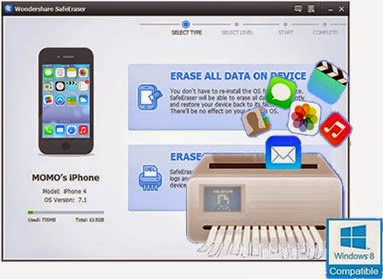As we all know that the personal information is a bit concern on iPhone as it plays an important role in our daily life, such as text messing, contacts, photos, social networking, payment and business. However,before selling the old iPhone device,we need to erase all data on iPhone permanently,eve no data recovery software can restore erased data back forever.If we erase iPhone data by restore factory setting,some data recovery software can get them back easily!However,how to
delete data on iPhone permanently without recovery?
Method 1: Factory Reset Your iPhone (100% Recovery Rate)
This is the simplest and fastest way to remove content and settings on your iPhone and this method has been widely adopted for general users. This is fairly enough for users who haven’t leave any important data on the iPhone. Below are the steps on how to achieve that:
Step 1: Tap on Settings icon on iPhone homescreen.
Step 2: Scroll down from the list and choose General option
Step 3: Select Reset at the bottom of the list and choose
Delete All Content and Settings.
Disadvantage : However, this method is not that secure in terms of high standards as the data can be recovered by utilizing this factory reset. If you really cared about your person information from being leaked, you should make sure that there is no chance to restore such content when you selling or handling the device to someone else. It is highly recommend to use the following method I am gonna to mention in the next section, as the data will be deleted permanently even the military forces can’t get them back.
Method 2: Erase All Data Stored on iPhone Permanently
Maybe most people still don’t know that actual contents of file are not really deleted when performing simple deletion operation on your iPhone or other devices. But they are just marked for deletion and not shown in the file system of your iOS device. The actual data are still physically present on your iPhone. For iOS system, the only way to completely erase the data is to overwrite the original contents.
 |
| Delete Data from iPhone 4/4S/5/5S Permanently |
If you want to completely eliminate all traces of data on your iPhone,
iPhone Data Eraser software could be a good choice, it provides four erasing options to ensure all deleted data were overwritten and erased without the possibility of recovery by any practical software or hardware methods. In this post, we'll show you how to permanently
erase all data from iPhone before selling.
Free download the iOS Data Eraser:


Step 1 Install iPhone Data Eraser
Download the .exe file or .dmg(for Mac) from below download link and double-click the file to begin installation process. There is a built-in wizard guiding you through the entire process. After that, the software will be opened automatically and a shortcut will display on computer desktop.
 |
| iOS Data Eraser software main interface |
Step 2 Connect iPhone to a PC and Select Right Earsing Option
Plug the iPhone to computer via USB cable. The program will detect the device once it was well connected. Then you can proceed to the next step. However, if the program can’t detect the device, please make sure iPhone USB driver and iTunes are installed properly on the computer.
 |
| Connect iPhone to a PC and start to scan your iPhone |
Note: The program offers 4 erasing option for your different demands: "
EXPRESS CLEANUP", "
ERASE PRIVATE Data", "
ERASE DELETED FILES" and "
ERASE ALL DATA". You can select the appropriate option and give it a try. As we want to erase everything stored on the iPhone, so the first method is preferred in this case. Select Erase All Data from the sidebar, which leads to the next step.
Step 3 Start Analyzing and Scanning the Data on Your iPhone.
In this step, it will automatically analyze and scan all your deleted files in your iPhone device; generally it takes few minutes to complete the process depending on the file. After scanning – select the deleted data to view detailed information on the file.
 |
| Analyzing and Scanning the Data on Your iPhone |
Step 4 Privew and Erase Data on your iPhone
After scanning, all deleted data will be scanned out and presented as details, by default, all files will be selected. Unselect the files you wish to keep.
 |
| Privew and Erase Data on your iPhone |
Step 5 Start Erasing Everything on iPhone
Input 'delete ' and click Start Button to confirm that you are going to erase all the data on the iPhone. Then the program starts erasing apps, music, videos, photo, contacts, SMS and other files stored on the device. It only takes a few minutes to complete the task.


It will ask you for confirmation before it starts erasing so make sure you are certain you want to continue as this is your last chance to prevent data from being accidentally erased. You should be no longer worries about your privacy being leaked by using the fancy program. Let’s being said, even the most sophisticated data recovery software isn’t able to get any information from the given device. It’s definitely worth the money you spent on it. And there is no additional fee if you use the program on multiple devices in future.
Tips: If you want to backup some useful data to computer before erase iPhone data with this ios data eraser,you can use this iPhone data transfer tool,which can help you transfer contacts, sms, photos, videos,ect from iPhone to computer directly.
























